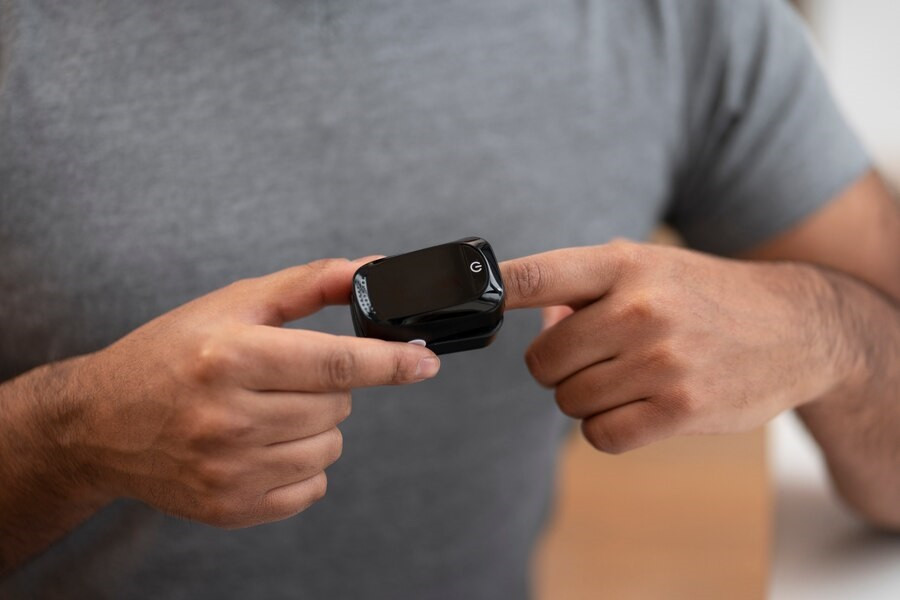Pulse oximeter atau oksimeter nadi adalah alat yang digunakan untuk mengukur kadar oksigen di dalam darah. Tes noninvasif ini hanya perlu ditempatkan di ujung jari, kemudian sensor cahaya yang melewati kulit akan mengukur seberapa banyak oksigen dalam sel darah merah dari darah pembuluh arteri.
Kadar oksigen yang terlalu rendah di dalam darah menandakan adanya masalah pada sistem pernapasan atau sirkulasi darah. Tes ini dapat membantu dokter mengevaluasi kinerja paru dan jantung serta memastikan bila tubuh menerima pasokan oksigen yang cukup. Selain itu, informasi ini bermanfaat untuk mengetahui bila seseorang memerlukan oksigen tambahan.
Cara Membaca Oksimeter
Cara menggunakan oksimeter cukup mudah. Anda hanya perlu melepas semua perhiasan atau menghapus cat kuku yang dapat mengganggu pembacaan. Pastikan juga tangan dalam keadaan hangat dan rileks serta diposisikan di bawah jantung.
Langkah-langkahnya:
- Pasang oksimeter pada jari tangan atau kaki dan tempatkan alat dalam posisi yang nyaman selama pengukuran
- Nyalakan perangkat dan biarkan alat melakukan pengukuran selama beberapa detik hingga satu menit, alat akan menampilkan denyut nadi dan kadar oksigen di dalam darah (saturasi oksigen)
- Setelah pengukuran, alat oksimeter bisa dilepas
Baca Juga: Benarkah Cat Kuku Menyebabkan Pembacaan Oximeter Tidak Akurat?
Cara Membaca Angka di Oksimeter
Angka yang tertera di oksimeter setiap orang tidak sama. Kondisi kesehatan yang melatarbelakangi bisa memengaruhi saturasi oksigen dan denyut nadi Anda.
Berikut adalah interpretasi dari pembacaan oksimeter:
- Saturasi oksigen (SpO2) 95-100% dengan denyut nadi 60-100 kali per menit artinya normal
- Saturasi oksigen (SpO2) 95% dengan denyut nadi 101-109 kali per menit artinya saturasi normal dan ada peningkatan denyut nadi, bisa dipantau sesuai kondisi
- Saturasi oksigen (SpO2) 93-94% dengan denyut nadi 110-130 artinya ada penurunan kadar oksigen dan peningkatan denyut nadi, Anda perlu memeriksakan diri ke dokter
- Saturasi oksigen (SpO2) 92% atau lebih rendah dengan denyut nadi 131 atau lebih bisa menandakan kadar oksigen yang rendah di darah, Anda perlu mendapat pertolongan medis segera di rumah sakit
Baca Juga: Ciri Saturasi Oksigen Rendah pada Pasien Isolasi Mandiri COVID-19 yang Perlu Diketahui
Kapan Perlu ke Dokter?
Tingkat saturasi yang normal adalah di antara 95-100%. Saturasi oksigen yang rendah dalam darah dapat menjadi masalah kesehatan serius yang disebut hipoksia. Hipoksia berarti terjadi penurunan oksigen pada jaringan tubuh Anda yang bisa menyebabkan berbagai macam gejala.
Ada beberapa jaringan tubuh yang bisa beradaptasi sementara terhadap penurunan kadar oksigen. Namun bila terus dibiarkan, kondisi ini bisa menyebabkan kerusakan organ. Kekurangan oksigen terutama pada otak dan jantung bisa berbahaya dan dapat menyebabkan kematian.
Selain pembacaan saturasi oksigen 92% atau di bawahnya, Anda perlu segera mencari pertolongan medis darurat bila mengalami gejala sakit kepala, kebingungan, kecemasan, denyut nadi tidak teratur, napas cepat atau sesak, atau warna kulit kuku dan bibir berubah menjadi kebiruan.
Manfaatkan pula layanan konsultasi kesehatan dengan dokter apabila Anda merasa kebingungan akan hasil pembacaan oksimeter Anda, dengan mengunduh aplikasi Ai Care melalui App Store atau Play Store.
Mau tahu informasi seputar penyakit lainnya? Cek di sini, ya!
- dr Hanifa Rahma
Stephanie Watson (2023). What Is Pulse Oximetry?. Available from: https://www.webmd.com/lung/pulse-oximetry-test
Lauren Evoy Davis (2023). How to Use a Pulse Oximeter to Check Oxygen Saturation Levels. Available from: https://www.ncoa.org/adviser/oxygen-machines/how-to-read-a-pulse-oximeter
Ana Gotter (2023). Pulse Oximetry: Purpose, Uses, and How to Take a Reading. Available from: https://www.healthline.com/health/pulse-oximetry
Karthik Kumar, MBBS. What Are the Benefits of Pulse Oximetry?. Available from: https://www.medicinenet.com/what_are_the_benefits_of_pulse_oximetry/article.htm
Cleveland Clinic (2022). Hypoxia. Available from: https://my.clevelandclinic.org/health/diseases/23063-hypoxia








